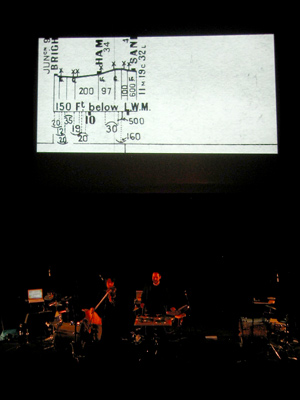5 September 2008
Aphids Reel Music Festival
 Image: Detail of Cryptomnesia by David Young
Image: Detail of Cryptomnesia by David Young © Aphids
The Aphids Reel Music Festival was all about exploring all of the possible intersections between live musical performance and the moving image. Held over four concerts, it explored some highly creative approaches as to how these two media might interact.
Waiting to Turn Into Puzzles is a collaborative work by composer David Young and video artist Louise Curham. The video and music had a similar feel in that they both explored a variety of unusual colours and textures. The music, especially, moved through many interesting, extended playing techniques, some with a quasi-improvisatory feel. Ensemble Offspring were extremely skillful in producing these sounds, especially in the way these timbres blended within the ensemble. This piece was characterised by subtle and delicate gestures. By using restrained gestures that resisted the urge to develop climactically, Young created a series of simple and ephemeral musical images.
The video work was similar – a series of delicate, ephemeral textures that didn't really undergo longer development. At times the music and video would enter into a passage where the two media complemented each other very powerfully, resulting in a unique experience where the video and music supported each other. Unfortunately this was not maintained throughout the piece. Sometimes the two media would diverge to the point where, personally, I found that one distracted me from the other.
Saturday night's program found entirely different ways for sound and image to interact. This concert presented Creation, by David Young, for violin and percussion (muted gongs and guiro), and a series of pieces by the Japanese trio D.V.D. Both found extremely interesting ways to utilise the moving images in a musical context.
Creation used the projected image as a graphic score, in which a vertical line moved across the screen from left to right, over what seemed to be some kind of topographical map, the composer using this random structure as a way to organise sounds. This type of notation was extremely effective. It allowed Young to communicate to the performers with great precision exactly when a gesture should happen – more so than traditional notation. This precision made it possible for the music to sustain interest by extremely simple and limited gestures. It also allowed Young to explore ideas that would have been very awkward to communicate in traditional modes of notation. For example, some of the lines on the score were realised musically as minute shifts in dynamic, this different mode of expression allowing greater detail and exploration of this particular aspect. Similarly, the violin part was almost exclusively glissandi, following the contour of a rising and falling line, never becoming stale and monotonous.
Eugene Ughetti and Yasukata Hemmi were excellent in their realisation of this score, treating their instruments just as creatively and uniquely as the notation. The Japanese trio D.V.D, a group consisting of two drummers/laptop musicians and a video programmer, were an entirely different experience. Immediately after the subtle playing of Ughetti and Hemmi, their pop stylings were a little abrasive. However their performance had a playfulness that engaged the audience.
D.V.D's performance found very direct ways for the music and image to interact, and this was done mostly through a kind of video game format, where sounds would trigger images and audio samples. In their version of a pin-ball machine, flippers on the screen were controlled by hits from the kick and snare drums, creating a playful sound world as the drummer tried to keep pin-balls from falling off the screen. These games were entertaining to watch, however their real success was in the way they created a reciprocal relationship between the sound and image.
Performance details
Aphids Reel Music Festival
Melbourne's Federation Square
26–29 June, 2008
Further links
David Young (www.amcoz.com.au/composers/composer.asp?id=212)
Ensemble Offspring (www.ensembleoffspring.com)
Aphids (www.aphids.net/)
Aphids Reel - review in RealTime (http://www.realtimearts.net/article/issue86/9127)

© Australian Music Centre (2008) — Permission must be obtained from the AMC if you wish to reproduce this article either online or in print.
Simon Charles is a composer and saxophonist, currently undertaking a master's degree in performance at the Victorian College of the Arts.
Comments
Be the first to share add your thoughts and opinions in response to this article.
You must login to post a comment.